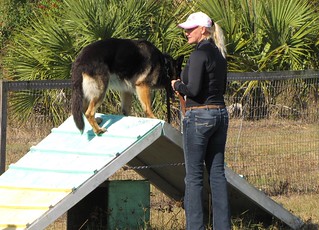Dog owners who are responsible know that good dogs are not made, they’re trained. Teaching your dog basic obedience skills, how to follow instructions and proper socialization will assure your pet is both happy and safe. You can work with your dog on your own, or get the help of a trainer. Here are some helpful ideas to get you going.
The space you share with your pet should be calm and relaxed. Your pet needs play time (and you might too), but your pet needs to be calm when you step into rooms most of the time. Calmly enter the house and ignoring your dog until you are ready to interact with him.
“Leave it” is a command that should be taught and reinforced early on. This is great if the dog chews on household furniture or other items, such as shoes, stuffed animals, or trash.
“No” shouldn’t be a huge part of training. You must find positive methods to reinforce your commands when training a dog. Telling them “no” does not help them know how to react to you. There is a difference in all dogs and training should be customized.
Positive Reinforcement
Use positive reinforcement when you are training your dog. Rewards include treats, kind words and physical touch. Do not shout or strike the dog. These are inneffective punishments and will only cause fear. Always be firm, be consistent and use positive reinforcement to make your dog understand what you want from it.
Toilet training is as much your responsibility as theirs. Pay attention for signs that your dog needs to go outside. Common ones include whining, pacing and even consistent staring. Don’t delay if you see your dog needs to go out. Put your dog on a leash and take him where he should go. Give him praise for proper toilet behavior. Soon, your dog will signal you when he needs to go outside.
Use your dog’s name often to get and keep his attention. It is especially important to do this during the first weeks of training, in order to establish that name-attention association. Give your dog a relatively short name, preferably one that isn’t likely to be confused with other words.
If you pour too much information and training into your puppy, it will actually be counterproductive. Remember that all dogs have short attention spans and puppies even more so. You want to end the session on a positive note; if you push too hard, he will end up dreading your training sessions.
To keep your dog from biting at furniture or people, or scratching at doors, spray him or her with a bottle of water. This will show the pooch that there are consequences to these actions. In no time you will have a well behaved pet of which you can be proud.
You should always praise your dog for his good behavior while you are training him. Show enthusiasm, smile widely and make sure the dog gets treats after exhibiting the behaviors you want. Do not reward unwanted behavior.
In canine training, socialization is of the utmost importance and must begin early. Your pet must know how to behave when it is around other humans and dogs – this isn’t something you could teach it otherwise. Also, this will reduce the chance of your dog embarrassing you.
Although it can be very difficult at times, patience should always be used with your dog. Your dog cannot speak or understand English, and does not have the cognizance of a human. An animal cannot grasp your thoughts and can only interpret your tone and nonverbal cues like gestures and facial expressions to some degree. If you or your dog seem frustrated, it’s time for a break.
Use these tips to help you to train the kind of dog you want to share your life with and share with others. Training your dog well makes your dog more fun to have around and cause less stress. Whether you decide to take on the challenge of training your dog yourself or you want to find a pro, training will help you enjoy many happy years with your dog.
Many people are searching for information concerning find out more, but most don’t find the best information. This article has provided a lot of information about find out more. Now put what you have read in this article to use.
